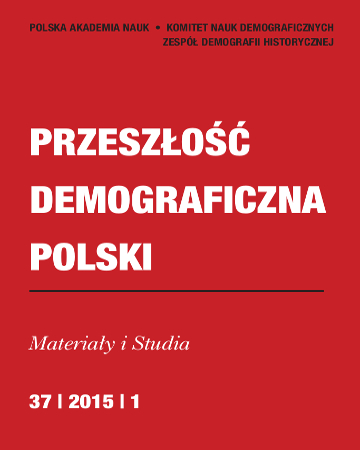Komputerowa mikrosymulacja sieci krewniaczej a wzorce współmieszkania: rzecz o demograficznych uwarunkowaniach rodziny chłopskiej w okresie staropolskim
A Computer Micro-Simulation of the Relative Network and the Patterns of Co-Habitation: on the Demographic Determinants of the Peasant Family in the Old-Polish Period
Author(s): Mikołaj SzołtysekSubject(s): History, Anthropology, Social Sciences, Sociology, Local History / Microhistory, Social history, Culture and social structure , History and theory of sociology, Social Theory
Published by: Wydawnictwo Naukowe Uniwersytetu Szczecińskiego
Keywords: family; household; network of relatives; peasants; Crown (of the Kingdom of Poland); Lithuania; Ukraine; 17th–18th centuries
Summary/Abstract: Resuming the threads that appeared in the book recently published Rethinking East-Central Europe: Family Systems and Co-Residence in the Polish-Lithuanian Commonwealth (Bern et al., Peter Lang, 2015) the author of this article presents the application of a computer micro-simulation of kin sets in the research on the demographic determinants of the structure of the residential family and the patterns of co-residence in the old-Polish era for the first time in the Polish literature. The first part of the article contains a review of the methods concerning the demographic determinants of the structure of the residential family and the patterns of co-habitation, and the essence of the experiment of demographic simulation, as well as some selected examples of its application in historical demography. For some time now this question has been widely discussed abroad (Laslett, Ruggles, Oeppen), but in the Polish literature there is no a single study dealing with that.The second part presents the source basis of the article; it is the database of the nominative censuses of 26,652 peasant households from the territories of the Crown, Lithuania and Ukraine from the end of the 18th century (CEURFAMFORM Database). The methodology of the applied micro-simulation model has also been discussed. A lot of space has been devoted to the question of the choice of outside parameters and the validation of the model, as a way to a better structuralisation of regional research on the old-Polish demography. It would be quite useful if the efforts of researchers might concentrate on fixing the necessary minimum programme for future analyses in microscale family reconstitution, so that their results would have a wider applicability in research of a higher rank (not only the one in which simulation modelling is used), and so that they would satisfy the basic requirements of comparative analysis.The third part deals with the applicability potential of the used methodology to analyse the influence of demographic factors on the co-residence patterns for old-Polish populations taken from the database CEURFAMFORM. The problem has been illustrated by presenting two current questions that are essential for historical demography of the family: the process of leaving the family house and co-habitation of various generations. The analysis shows how the combined impact of fertility, mortality and the generational overlap in their regional configurations, determining the number and category of the relatives in a given population, shaped the dominant patterns of co-habitation in the territories that have been researched. The conclusions should be treated as innovative, yet future investigations might verify that. For the time being they constitute a convenient map that indicates directions for further investigations, both quantitative and qualitative in nature.
Journal: Przeszłość Demograficzna Polski
- Issue Year: 37/2015
- Issue No: 1
- Page Range: 107-161
- Page Count: 55
- Language: Polish

